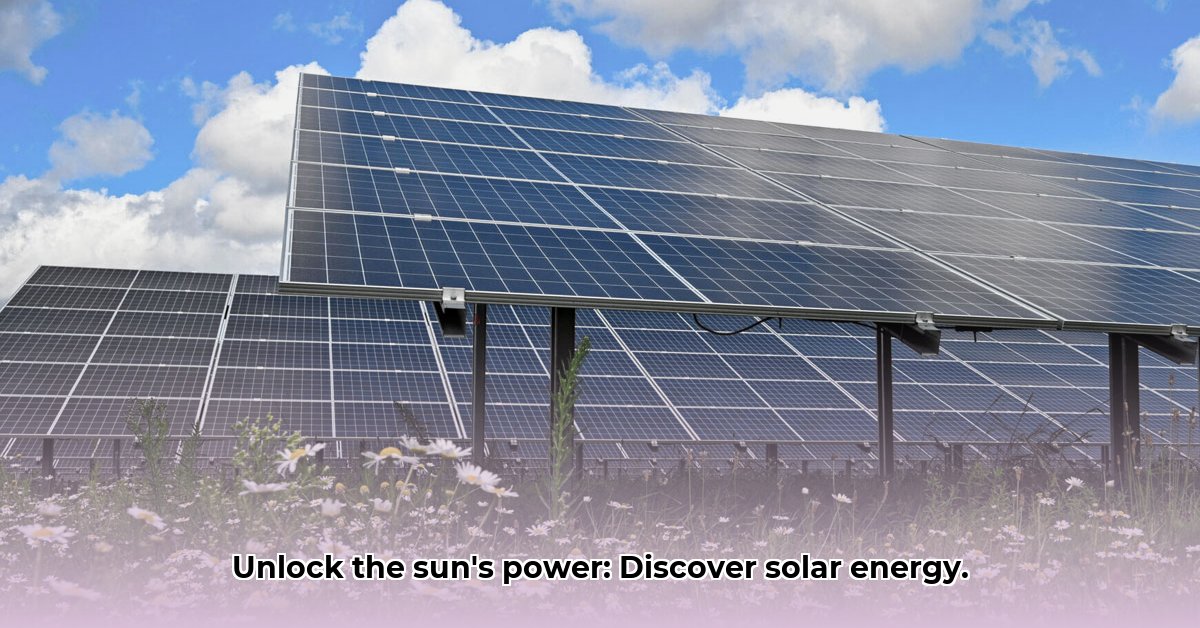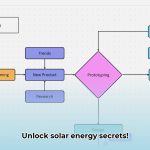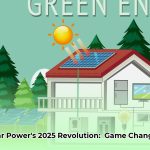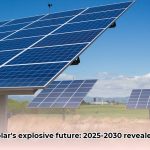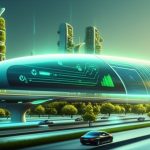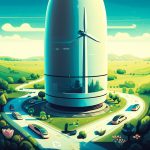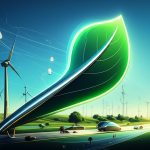Thinking about transitioning to solar power but feeling overwhelmed? It’s more approachable than you might think! Solar energy offers a diverse range of options for harnessing the sun’s power. This guide simplifies the key types of solar energy, explaining how they operate, their advantages and disadvantages, and their real-world applications. Whether you’re considering solar panels for your home, exploring renewable energy solutions for your business, or simply curious about clean energy, this guide will provide a clear understanding of solar energy’s potential to power our future while also avoiding energy insecurity. For a deeper dive into solar energy types, check out this comprehensive guide: Solar Energy Types.
Exploring Different Solar Energy Options for Homes and Businesses
Let’s embark on an exploration of the diverse world of solar energy! Beyond the familiar rooftop panels lies a universe of methods to capture the sun’s energy. This guide delves into the distinct types of solar energy, their respective advantages and disadvantages, and what defines their unique status. We will explore various emerging solar technologies that are being developed.
Photovoltaic (PV) Solar Energy: Powering with Direct Sunlight Conversion
Photovoltaic (PV) solar energy, commonly seen as panels on rooftops and in solar farms, directly converts sunlight into electricity using photovoltaic cells. These cells act like tiny, sunlight-powered batteries, transforming solar radiation into usable power. When sunlight strikes a PV cell, photons (light particles) excite electrons in the semiconductor material (typically silicon), creating an electric current. Multiple cells are connected to comprise a solar panel. These panels can be arranged in arrays to meet specific energy needs. While generally straightforward to install, their effectiveness depends on sunlight availability and panel quality. Did you know that PV systems require minimal maintenance once installed, saving both time and money?
Advantages:
- Green Energy: A clean, environmentally responsible electricity generation method reduces your carbon footprint and promotes sustainable energy solutions.
- Low Upkeep: Minimal maintenance post-installation saves time and money. Cleaning may be required periodically in dusty environments.
- Relatively Affordable: Decreasing initial costs increase accessibility, driven by technological advancements and economies of scale.
- Scalability: PV systems can be scaled to fit diverse needs, from small residential setups to large utility-scale solar farms.
Disadvantages:
- Weather Dependent: Cloud cover and nighttime reduce power generation, necessitating a backup power source (like batteries or grid connection) for crucial needs.
- Space Requirements: Large-scale solar farms need considerable land, sparking potential land-use debates.
- Environmental Considerations: The manufacturing of solar panels impacts the environment, including the use of rare earth materials and energy-intensive processes (though continuously improving with recycling initiatives and sustainable manufacturing practices).
- DC to AC Conversion: PV systems produce direct current (DC) electricity, which must be converted to alternating current (AC) for most home and business uses, resulting in some energy loss in the conversion process.
Concentrated Solar Power (CSP): Large-Scale Sunlight Focusing for Power Generation
Concentrated Solar Power (CSP) systems use mirrors or lenses to focus sunlight onto a single point, generating heat to power a turbine and produce electricity. This mimics traditional power plants but uses solar energy instead of fossil fuels. The concentrated sunlight heats a fluid (often oil or molten salt), producing steam that drives a turbine connected to a generator. CSP excels in sunny, desert-like climates with abundant direct sunlight. These plants require expansive land areas and a high initial investment.
Advantages:
- High Efficiency Potential: CSP systems can potentially achieve higher efficiency levels compared to some other solar technologies, maximizing energy conversion.
- Energy Storage: Thermal storage (using molten salt, for example) enables electricity generation even after sunset, addressing the intermittency challenge common to other solar approaches. This allows for dispatchable power, meaning electricity can be produced when needed, not just when the sun is shining.
- Grid Stability: CSP plants can provide grid stability services, such as frequency regulation, similar to conventional power plants.
Disadvantages:
- High Initial Investment: Building CSP plants requires significant upfront capital, including the cost of mirrors, receivers, turbines, and thermal storage infrastructure.
- Land Intensive: Similar to large PV farms, substantial land is needed to accommodate the mirror field and associated equipment.
- Geographic Limitations: Performance is best in consistently sunny, arid regions where direct sunlight is abundant (high direct normal irradiance or DNI).
- Water Usage: Some CSP technologies require significant amounts of water for cooling, which can be a concern in arid regions.
- Environmental Impact: Land disturbance, wildlife impacts, and the use of potentially hazardous materials (like molten salt) are environmental concerns.
Solar Thermal Collectors: Natural Water Heating with Solar Heat
Solar thermal collectors harness the sun’s heat for practical applications. They function as solar-powered water heaters, heating water or air for household hot water or space heating. This reduces reliance on fossil fuels for heating. Flat-plate collectors are common, consisting of an insulated box with a dark absorber plate covered by glass or plastic. Evacuated tube collectors offer higher efficiency, especially in colder climates. Are you aware solar thermal collectors are a simple yet effective way to reduce your dependence on fossil fuels for heating?
Advantages:
- Lower Energy Bills: Reduces reliance on traditional heating systems, saving energy and potentially lowering bills.
- Eco-Friendly: A cleaner alternative to fossil fuel-based heating, reducing greenhouse gas emissions.
- Low Maintenance: Relatively simple systems require minimal upkeep.
- Increased Property Value: Can increase the resale value of a home.
Disadvantages:
- Sunshine Dependent: Output is directly tied to sunlight availability. Cloudy days reduce efficiency.
- Geographic Limitations: Less effective in areas with frequent cloud cover or colder climates (although evacuated tube collectors perform better in cold).
- Limited Application: Primarily focuses on heating; it doesn’t directly generate electricity.
- Aesthetic Concerns: Some homeowners find solar thermal collectors visually unappealing.
- Freezing Risk: In colder climates, there is a risk of freezing if the system is not properly designed and maintained.
Emerging Solar Technologies: A Glimpse into the Future
The solar energy landscape is continuously evolving. Scientists and engineers actively develop cutting-edge technologies. Perovskite solar cells show great promise, potentially offering higher efficiency and lower costs than traditional silicon-based cells. These materials have a crystal structure similar to the mineral perovskite. Organic solar cells are another research area, potentially producing flexible, lightweight solar panels for diverse applications. Quantum dot solar cells, dye-sensitized solar cells (DSSCs), and bifacial solar panels are also garnering attention.
A Quick Comparison: Understanding Solar Energy Options
Here’s a table summarizing key features of different solar energy types:
| Type of Solar Energy | Efficiency (%) | Typical Cost (USD/kW) | Lifespan (Years) | Environmental Impact | Best Suited For |
|---|---|---|---|---|---|
| Photovoltaic (PV) | 15-22 | 1000-3000 | 25-30 | Moderate | Homes, businesses, utility-scale |
| Concentrated Solar Power | 15-35 | 4000-6000 | 30-40 | Moderate | Large-scale power generation in sunny regions |
| Solar Thermal Collectors | Highly Variable | 200-1000 | 15-20 | Low | Water & space heating |
The best solar energy choice depends on individual needs, location, climate, and budget. Research and consult with experts for the perfect solar solution. The future of solar power is continuously brightening.
How to Compare Long-Term Cost-Effectiveness of Renewable Energy
Determining the long-term cost-effectiveness of renewable energy sources requires a broad perspective considering factors beyond initial investment. Key aspects include initial capital costs, operational and maintenance costs, lifespan, performance, environmental impact, and government incentives. In addition, energy storage requirements must be considered, adding to the total cost. The levelized cost of energy (LCOE) is a commonly used metric for comparing the cost-effectiveness of different energy sources over their lifetime.
Key Insights:
- The cost of solar and wind power has fallen considerably, making them more affordable than fossil fuels in many regions.
- Renewable energy sources boast long-term cost advantages when considering their complete lifecycle, including fuel costs (which are zero for solar and wind).
- Factors like energy storage, grid infrastructure upgrades, and government policies heavily influence renewable energy economics.
- Carbon pricing mechanisms (like carbon taxes or cap-and-trade systems) can further enhance the cost-competitiveness of renewable energy by internalizing the environmental costs of fossil fuels.
Photovoltaic (PV) Solar Energy in Detail
PV solar energy directly uses sunlight to generate electricity by exciting electrons in photovoltaic cells. This technology is widely utilized, from rooftop installations to large solar farms. PV systems are modular in design and are relatively low maintenance and decreasing production costs. Advancements in solar cell technology (like PERC, TOPCon, and heterojunction cells) are continuously improving efficiency and lowering costs.
Pros: Lower maintenance, modular design (easily scalable), decreasing production costs, suitable for a wide range of applications (from small to large scale), relatively quick installation.
Cons: Intermittency (sunlight dependence), land use requirements for large-scale projects, manufacturing process impacts, requires inverters to convert DC to AC power, energy storage may be needed for reliable 24/7 power.
Concentrated Solar Power (CSP) in Detail
CSP systems focus sunlight using mirrors or lenses onto a receiver, generating heat to drive a turbine and produce electricity. This approach can store thermal energy for use at night or when sunlight is low, providing dispatchable power. However, high initial capital costs are a geographic limitation.
Pros: Can store thermal energy for use at night or during periods of low sunlight, potentially higher efficiency than PV, provides dispatchable power, can provide grid stability services.
Cons: High initial capital costs, geographic limitations (requires high solar irradiance), potential environmental impact from land use and water consumption, more complex technology than PV.
Emerging Solar Technologies in Detail
Innovations continue to drive the field, for example, Perovskite solar cells, which offer potential for higher efficiency and lower manufacturing costs compared to traditional silicon-based cells. However, challenges remain in terms of stability, longevity, and potential toxicity. Bifacial solar panels, which generate electricity from both sides, are also gaining popularity. Continual research and development continue to improve solar energy’s potential.
Long-Term Cost-Effectiveness: Methodology Details
The levelized cost of electricity (LCOE) is a vital metric for assessing long-term cost-effectiveness. It takes into account the total cost of building and operating a power plant over its lifetime, divided by the total electricity generated. Location, technology, and capacity factor dramatically influence LCOE. Government incentives, subsidies, and the need for energy storage also impact overall costs. Careful consideration of environmental impacts and geographical limitations is crucial.
Here’s a simplified comparison table:
| Technology | Initial Cost | Operational Cost | Lifespan (Years) | Efficiency (%) | Environmental Impact |
|---|---|---|---|---|---|
| PV Solar | Medium | Low | 25-30 | 15-22 | Relatively Low |
| CSP Solar | High | Medium | 30-40 | 15-35 | Moderate |
| Wind Turbines | High | Low | 20-25 | 30-50 | Moderate |
Solar Energy Solutions for Rural Electrification
For rural communities, solar energy offers a powerful pathway to enhance agricultural resilience by addressing energy insecurity while providing reliable water supply. However, successful implementation depends on overcoming financial hurdles, infrastructure gaps, and knowledge limitations and requires effective strategies involving farmers, governments, NGOs, and energy providers. Community engagement and capacity building are crucial for ensuring the long-term sustainability of rural electrification projects.
Key Insights:
- Solar energy offers a powerful pathway to enhance agricultural resilience in rural areas by addressing energy insecurity.
- Successful implementation hinges on overcoming financial hurdles, infrastructure gaps, and knowledge limitations.
- Several solar technologies exist, each with unique strengths and weaknesses, requiring careful consideration based on specific needs.
- A holistic approach that considers social, economic, and environmental factors is essential for successful rural electrification.
Photovoltaic (PV) Solar Systems Overview
PV systems transform sunlight directly into electricity using panels containing photovoltaic cells. Sunlight striking these cells creates an electron flow, generating electricity for homes or larger agricultural operations. PV systems are relatively low maintenance and modular. However, the efficiency depends on sunlight and initial investment can be high.
Pros: Relatively low maintenance, modular (easy to expand), and environmentally friendly. Easy to install and operate.
Cons: Efficiency depends on sunlight availability; initial investment can be high; requires battery storage for nighttime use; land use considerations.
Concentrated Solar Power (CSP) Systems Overview
CSP systems use mirrors or lenses to focus sunlight onto a receiver, generating heat to drive a turbine and produce electricity. This offers the advantage of storing energy as heat, enabling electricity generation even after sunset. An advantage is that it has a higher efficiency. Concentrated solar power is more appropriate for large-scale power generation, which may or may not be useful in rural electrification depending on population density.
Pros: Higher efficiency than PV in sunny climates; energy storage capabilities; potential for large-scale power generation.
Cons: High initial costs; requires large land areas; the technology is more complex; requires skilled labor for maintenance and operation; water usage can be a concern.
Solar Water Pumping Systems Overview
Solar water pumping systems lift water for irrigation using PV panels to directly power pumps, eliminating reliance on fossil fuels. This is crucial for water-intensive agriculture in arid and semi-arid reasons and provides a reliable water supply. These systems can significantly improve agricultural productivity and food security.
Pros: Reliable water supply; reduced operating costs; environmentally sustainable; can operate independently of the grid.
Cons: Performance is affected by sunlight intensity; requires regular maintenance; may not be suitable for all pump types; initial investment can be a barrier for some farmers.
Hybrid Solar Systems Overview
Combining different solar technologies, such as PV and CSP, gives greater flexibility, reliability, and optimized energy management. But keep in mind that higher initial investments are more complex. Hybrid systems can also incorporate other renewable energy sources, such as wind or biomass.
Pros: Increased efficiency and reliability; better utilization of available resources; optimized energy management; can provide a more stable power supply.
Cons: Higher initial investment; more complex system design and maintenance; requires expertise; requires careful planning and coordination.
Mini-Grids Overview
Mini-grids are localized power distribution networks particularly valuable in areas with limited grid access. Powered by solar energy (potentially with other renewables), they provide a sustainable electricity solution improving energy access and fostering economic development.
Pros: Provides electricity to multiple users; improves energy access; promotes economic development; can foster local entrepreneurship and job creation.
Cons: High initial setup costs; requires expertise in grid management; vulnerable to outages if power generation or distribution is disrupted; requires community involvement and cooperation.
Comparative Chart
Here is a comparison of solar solutions for rural electrification:
| Solar Solution | Efficiency | Cost | Lifespan (Years) | Environmental Impact | Suitability for Rural Electrification |
|---|---|---|---|---|---|
| PV Systems | Moderate | Moderate | 25-30 | Low | High |
| CSP Systems | High | High | 30-40 | Moderate | Medium (depending on scale and water availability) |
| Solar Water Pumping Systems | Moderate | Low-Moderate | 15-20 | Low | High (for irrigation) |
| Hybrid Systems | High | High | 25-35+ | Low | Medium-High |
| Mini-Grids | Variable | High | 20-30+ | Low | High (for community electrification) |
Comparative Analysis of Solar Panel Technologies for Different Climates
Selecting the optimal solar panel technology depends on climate and energy needs. In tropical climates, amorphous silicon (a-Si) and HIT solar panels frequently show better array yield and performance ratio compared to other technologies. However, HIT systems show greater power fluctuations, posing challenges for grid integration, but machine learning models accurately predict power output variations, aiding grid management and energy market participation and allowing the accurate yield of solar panels. Degradation rate and long term reliability should be taken into account when considering solar panel technology for different climates.
Key Insights:
- Amorphous silicon (a-Si) and HIT solar panels consistently outperform other technologies in array yield and performance ratio in tropical climates due to their better performance in diffuse light conditions.
- However, HIT systems show greater power fluctuations than other types, posing challenges for grid integration. Effective grid management strategies are needed to mitigate these fluctuations.
- Choosing the right solar panel technology depends heavily on climate and energy needs, as well as factors like available space, budget, and grid connectivity.
Crystalline Silicon (c-Si) Solar Panels Overview
Crystalline silicon (c-Si) solar panels are the standard in the solar industry, proven, widely available, and relatively affordable, with monocrystalline (sc-Si) and multicrystalline (mc-Si) options. They generate an electrical current when sunlight excites electrons in silicon. Performance is good for mature technology.
- Mechanism: Sunlight excites electrons in silicon, generating an electrical current.
- Pros: High efficiency (especially sc-Si), long lifespan, mature technology, widely available, relatively affordable.
- Cons: Can be more expensive than thin-film options, less efficient in low-light conditions, performance degrades at higher temperatures.
Thin-Film Solar Panels Overview
Thin-film solar panels are innovative, often aesthetically pleasing, and potentially cheaper. They’re flexible and adaptable, the different types include amorphous silicon (a-Si), cadmium telluride (CdTe), and copper indium gallium selenide (CIGS). Thin-film solar panels are lightweight and can potentially lower manufacturing costs.
- Mechanism: Sunlight interacts with a thin layer of semiconductor material, generating electricity.
- Pros: Lightweight, flexible, can be produced on various substrates, potentially lower manufacturing costs, better performance in diffuse light conditions (making them suitable for cloudy climates).
- Cons: Generally lower efficiency than c-Si, shorter lifespan in some cases, some thin-film technologies use toxic materials (e.g., cadmium telluride).
Perovskite Solar Cells Overview
Perovskite solar cells are a newer technology under development, offering impressive potential efficiency gains but less cost-effective or durable than established technologies. Stability and longevity are significant challenges, and the toxicity of some components requires attention. The cells absorb sunlight and generate electricity with a unique crystal structure that can be used for unique crystal structure. Encapsulation techniques and material innovations are being explored to improve the stability and reduce the toxicity of perovskite solar cells.
- Mechanism: Perovskite materials absorb sunlight and generate electricity with a unique crystal structure.
- Pros: Potential for very high efficiency, low manufacturing costs (in the future), flexible, can be used in tandem solar cells to further increase efficiency.
- Cons: Stability and longevity are major challenges, toxicity of some components requires attention, still in the early stages of development.
Heterojunction with Intrinsic Thin-layer (HIT) Solar Cells Overview
Heterojunction with Intrinsic Thin-layer (HIT) Solar Cells are a hybrid approach, combining thin-film and crystalline silicon technologies. They offer better performance than traditional silicon panels but have a higher cost. Additionally, these cells use a mix of layers for improved efficiency.
- Mechanism: These solar cells use a combination of amorphous silicon and crystalline silicon layers for improved efficiency.
- Pros: High efficiency, good performance in low-light conditions, excellent temperature coefficient (meaning they perform well at higher temperatures).
- Cons: Higher cost compared to standard c-Si panels, less widely available, more complex manufacturing process.
Climate and Performance Chart
Temperature, sunlight, and other climate variables affect solar panel performance. Tropical climates need panels that resist high temperatures without significant degradation. The better the temperature resistance, the more reliable the panels get under high temperature resistance.
| Technology | Efficiency (%) | Cost | Lifespan (years) | Temperature Sensitivity | Best Climate |
|---|---|---|---|---|---|
| sc-Si | 18-22 | High | 25-30 | Moderate | Temperate, Sunny |
| mc-Si | 15-18 | Medium | 25-30 | Moderate | Temperate, Sunny |
| a-Si | 5-8 | Low | 15-20 | High | Tropical, Cloudy |
| CdTe | 10-12 | Medium | 20-25 | Low | Hot, Arid |
| CIGS | 10-13 | Medium-High | 20-25 | Low | Hot, Arid |
| Perovskite | Up to 25 | High | Variable | High | Temperate (with further development) |
| HIT | 20-23 | High | 25-30 | Low | Tropical, Temperate |
- Vertical Axis Wind Turbine Design: Improving Efficiency and Overcoming Limits - October 29, 2025
- Wind Turbine to Power Home: Nacelle Design Improvements Advance - October 26, 2025
- Wind Turbine Blade Length: How Long Is Too Long? - October 24, 2025
